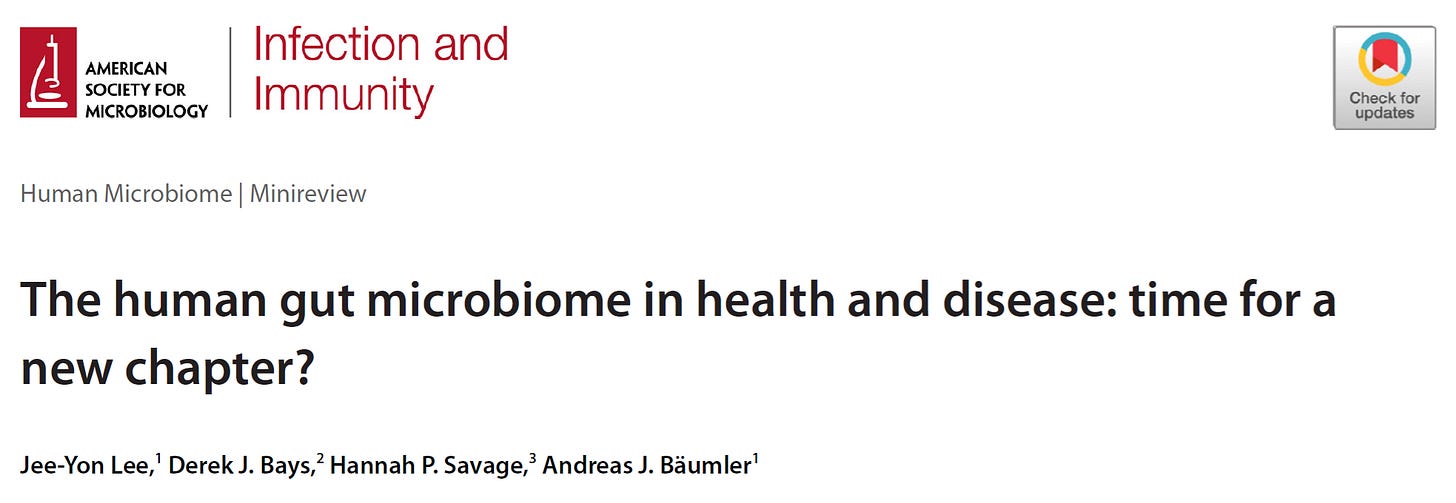Time for a new chapter focused on the gut environment
And an exclusive look at my approach to support it
I’ve long been a fan of Dr. Andreas Bäumler’s research. His work is heavily featured in my articles on the oxygen-gut dysbiosis connection and a new framework for microbiome research, and his emphasis on reframing gut dysbiosis around environmental conditions and functions rather than fixating on specific taxa has strongly influenced how I understand and approach gut health.
Below, I’ve distilled several core lessons from his lab’s most recent review, which reinforces many of these guiding principles. Toward the end, I’ll also cover some common pitfalls in “gut health”, and offer an exclusive look at how this focus on the gut environment translates into practical actions to support gut health.
Time for a paradigm shift in gut health & disease
Insights from a recent review by Lee et al.
1. More data isn’t the answer
“If the outcome of the human microbiome project is any indication, continuing down the path of scaling up discovery-driven research […] is not likely to succeed in establishing a conceptual framework for microbiome research.”
Despite massive data sets, we have made little progress in defining what constitutes a “healthy microbiome.” Cataloging more and more species is unlikely to be the panacea of gut health.
2. Think in terms of functional groups, not core species
“…what if the goal is not to select for core species in the colonic microbiota but for ecological guilds…?”
Rather than hunting for a universal set of “core” microbes, the authors suggest focusing on ecological guilds, groups of microbes that share similar resource needs. This approach emphasizes function over taxonomy, encouraging us to think about what these organisms do, rather than which genus or species they belong to.
3. Expand the definition of “microbiome” to include the host environment
“There is a growing consensus that microbes and their genes comprise only one part of our microbiome […] Broadening the definition of the term microbiome is not mere semantics.”
When we consider the environment (i.e., host factors like oxygen levels, mucus health, immune function, and nutrient availability) alongside the microbes themselves, we gain a more complete picture of gut health. A healthy gut has evolved functions that select for a healthy microbial composition.
4. Redefine dysbiosis as a weakened host environment
“…it has been proposed that dysbiosis should not be defined based on species richness or taxonomic identity, but that it generally represents a state of weakened host control over the microbial environment.”
This shift helps us see that dysbiosis most often stems from changes in the gut environment, rather than simply changes in microbial composition. If the underlying physiological conditions of the gut are compromised, then pathogens may thrive or overgrowth may occur — but this is a symptom, not the root cause. Thus, an altered microbiome is indicative of deeper dysfunction.
Common Pitfalls in “Gut Health”
With these principles in mind, it’s easy to see why focusing too heavily on individual microbes can lead to misguided treatment practices. Some common pitfalls include:
Obsessing over the abundance of a particular genus or species on a stool test.
Chasing strategies to “boost” levels of Akkermansia or Faecalibacterium.
Expecting isolated probiotics to be a magic bullet solution
Using potent herbal antimicrobials or antibiotics to “kill off” harmful microbes
All the while:
Ignoring the role of stress and sleep, and the impact of environmental toxins
Failing to address key micronutrient deficiencies and support gut energy metabolism
Not considering the impact of other organ systems on the gut
Remaining sedentary and socially isolated
Suppressing certain microbes with antimicrobials or obsessively seeking out “beneficial” strains won’t address the deeper environmental drivers of gut dysfunction, just as taking statins doesn’t solve the root causes of metabolic dysfunction. A flourishing microbiome is much more about the health of the host environment than it is about the composition of the microbes themselves.
How to Support the Gut Environment for a Healthy Microbiome
In the exclusive members-only section below, I share what I believe to be the core foundations of a healthy gut environment (and thus a healthy microbiome).
Keep reading with a 7-day free trial
Subscribe to Lucy Mailing, PhD to keep reading this post and get 7 days of free access to the full post archives.


